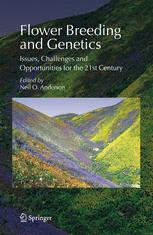
Flower Breeding and Genetics: Issues, Challenges and Opportunities for the 21st Century PDF
Preview Flower Breeding and Genetics: Issues, Challenges and Opportunities for the 21st Century
FLOWER BREEDING AND GENETICS Flower Breeding and Genetics Issues, Challenges and Opportunities for the 21st Century Edited by NEIL O. ANDERSON University of Minnesota, St. Paul, Minnesota, U.S.A. A C.I.P. Catalogue record for this book is available from the Library of Congress. ISBN 978-1-4020-6569-9 (PB) ISBN 978-1-4020-4427-4 (HB) ISBN 978-1-4020-4428-1 (e-book) Published by Springer, P.O. Box 17, 3300 AADordrecht, The Netherlands. www.springer.com Caption of cover illustration: Wildflowers of the Carizzo Plains (San Luis Obispo County, California, U.S.A.) burst into bloom after heavy winter rains in Spring, 2005. This photo illustrates the many wild, flowering species across the globe which have yet to be collected, bred, and domesticated as flowering crops. Photo Credit: Jean Gordon, Jeff Gordon (San Luis Obispo, California, U.S.A.) Printed on acid-free paper All Rights Reserved © 2007 Springer No part of this work may be reproduced, stored in a retrieval system, or transmitted in any form or by any means, electronic, mechanical, photocopying, microfilming, recording or otherwise, without written permission from the Publisher, with the exception of any material supplied specifically for the purpose of being entered and executed on a computer system, for exclusive use by the purchaser of the work. Table of Contents Colour Figures ix Part I Flower Breeding Program Issues Introduction. 3 Neil O. Anderson Chapter 1. Factors affecting flowering in ornamental plants 7 John Erwin Chapter 2. Creation of new floral products. Annualization of perennials— 49 Horticultural and commercial significance H arold Wilkins and Neil O . Anderson Chapter 3. Cultivar testing. America’s trial gardens 65 Jim Nau Chapter 4. Protection: Plant patents, utility patents, plant breeders’ rights, 81 trademarks, branding, royalties Penny Aguirre Chapter 5. Herbaceous ornamental plant germplasm conservation and use. 113 Theoretical and practical treatments David Tay Chapter 6. Prevention of invasiveness in floricultural crops 177 Neil O. Anderson Part II Crop-specific Breeding & Genetics BEDDING PLANTS Chapter 7. Ageratum. Ageratum houstonianum 219 Loren Stephens Chapter 8. Anagallis. Anagallis monellii 225 Rosanna Freyre Chapter 9. Begonia. History and breeding 241 Anne Kathrine Hvoslef-Eide and Cristel Munster Chapter 10. Impatiens. Impatiens wallerana 277 Michael S . Uchneat vi Contents Chapter 11. Petunia. Petunia x hybrida 301 Robert J. Griesbach Chapter 12. Zinnia. Zinnia elegans, Z. angustifolia 337 Dennis Stimart and Thomas Boyle FLOWERING POTTED PLANTS Chapter 13. Cacti Schlumbergera truncata, S . x buckleyi, 361 Hatiora gaertneri Thomas Boyle Chapter 14. Chrysanthemum. Dendranthema x grandiflora Tzvelv 389 Neil O. Anderson Chapter 15. Cra pemyrtle. Lagerstroemia indica 439 Margaret Pooler Chapter 16. Cyclamen. Cyclamen persicum Mill 459 Takejiro Takamura Chapter 17. Hibiscus. Hibiscus rosa-sinensis 479 G.A. Akpan Chapter 18. Lachenalia. Lachenalia spp 491 Riana Kleyhans, Chapter 19. Lily. Lilium hybrids 517 Ki-Byun. g Lim and Jaap M. Van Tuyl Chapter 20. Orchids. Dendrobium 539 Adelheid R. Kuehnle Chapter 21. Ornamental pepper. Capsicum annuum 561 John R. Stommel and Paul W. Bosland Chapter 22. Exacum. Exacum affine and related species 601 Andrew Riseman Chapter 23. Tulip. Tulipa gesneriana and Tulipa hybrids 623 Jaap M. Van Tuyl and Marjan G.M. van Creij Contents vii CUT FLOWERS Chapter 24. Lisianthus. Eustoma grandiflorum 645 Brent K. Harbaugh Chapter 25. Freesia. Freesia x hybrida 665 Li Wang Chapter 26. Rose. Rosa x hybrida 695 David C. Zlesak Chapter 27. Star of Bethlehem. Ornithogalum 741 Gail M. Littlejohn HERBACEOUS PERENNIALS Chapter 28. Monarda, Bee-balm. Monarda didyma 757 Campbell G. Davidson Chapter 29. Clematis. Clematis species 781 Dale T. Lindgren Chapter 30. Coneflower. Echinacea species 801 James R. Ault Figure 3-1. Example comparison or row trials planted in a color-coordinated grid system at Ball Seed Company, West Chicago, Illinois, U.S.A. Figure 3-2. An example large-sized hanging basket at the Ball Seed Company trials, featuring mixed plantings of flowering and foliage annuals and perennials. This basket contains Plectranthus ‘Nicoletta’, Lantana camara ‘Samantha’, Perilla ‘Magilla’, Petunia x hybrida ‘Suncatcher Pink’, and Sanvitalia procumbens. Figure 5-1. The centers of origin for some common flower crops. Figure 5-2. A restored remnant of the N. American Prairie in Dane County, Wisconsin. This illustrates the pressure of urban development on the Ice Age National Scenic Trail, which runs along the edge of the last Ice Age glacier 15,000 years ago. Figure 5-3. The primary (1º), secondary (2º) and tertiary (3º) genepools of a crop illustrating the growing boundary of tertiary genepool to encompass genes from all living organisms and human-made synthetic genes based on Harlan’s Genepool Concept. Figure 6-1. Purple loosestrife, Lythrum salicaria, is a horticultural noxious weed and invasive species throughout most of the United States and Canada. Photo credit: Luke Skinner, Minnesota Department of Natural Resources. Figure 6-2. Aggressive crops such as bishop’s cap or snow-on-the-mountain (Aegopodium podagraria) spread vegetatively and completely fill in an area until they reach physical barriers. Figure 8-6. Flowers of 'Skylover' and 'Sunrise' (top left and right, respectively) and blue, violet, red and orange flowers in Anagallis hybrids (bottom, from left to right). Figure 8-7. Blue and orange-flowered UNH Anagallis hybrids grown in 25 cm. hanging baskets in greenhouse Summer trials in 2001. Figure 9-1. Close up of the flowers, Symbegonia arfakiensis. Figure 9-3.Begonia x tuberhybrida Voss selections, illustrating the various plant habits, uses, and flower coloration. Figure 10-1. Claude Hope, ‘El Capitan’ as he was known to his co-workers, working at his farm in Costa Rica.
